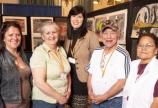Children’s residential school art portrays a truth
- Anne MacLaurin

Human faces, landscapes, cultural stories, wildlife and abstract shapes are just some of the depictions found in a collection of children’s art created during the years 1958-60 at the Alberni Indian Residential School. Each piece of art tells a story about a child who did not have a voice.
“The legacy of the residential schools speaks through the artwork,” says UVic visual anthropologist Dr. Andrea Walsh. “Standing in front of the paintings brings you into that child’s moment—there is immediacy to the experience.”
The children’s paintings are now part of the University of Victoria Art Collections and Walsh’s community-based research project. The paintings were bequeathed to the university by Robert Aller, the artist who was hired to teach weekly art classes at the Alberni Residential School in the late 1950’s.
“Our hope is to embrace an open access policy with the artwork,” says Walsh. “We want all the elders and the public to have access to these paintings.”
Walsh works very closely with Elders’ Voices (elders present on campus to guide students, staff, faculty and administration in Indigenous ways of knowing) on campus, the Nuu-chaha-nulth people and the community of Port Alberni. The elders play a key role in the community-based research project’s methodology and are the foundation for the entire project.
“The elders’ expertise and close involvement is what makes this project special,” says Walsh. “Often it is the elders leading this project, carrying out their vision.”
For instance, during last month’s Truth and Reconciliation Commission (website) regional event in Victoria, the children’s artwork was displayed in the Fairmont Empress Hotel during the two day event. The elders expertly took the lead on how the children’s art would be carried into the room in which they would be displayed for participants at the TRC regional event.
“The paintings can’t be stacked; every child must be carried,” instructed Cheryl Johnson, one of the women who organized the dancers for the pre-TRC installation of the artwork at the Victoria Conference Centre.
The pre-TRC event to hang the paintings with the participation of survivors, family members of the child artists and their communities took the form of a memorable ceremony. Over 40 Nuu-chaha-nulth women dancers each carried a single piece of art into the space. They were led into the room by men singers, who filled the hotel with their voices and drums. For Walsh, that was the moment she let go of control and watched as the surivors’ and elder’s took over the handling of the paintings.
For this special ceremony over 100 Nuu-chaha-nulth people travelled to Victoria to bear witness and view the 47 pieces of residential school artwork. Over two days more than 1,600 members of the public viewed the art.
“Rich, tragic, emotional and hopeful," says Deb George (elder-in-training and UVic coordinator of Elder Voices’) about the survivor stories she heard during the weekend. “The paintings help memories come alive and this is very important for healing,” says George.
Walsh acknowledges huge contributions and expertise of Elders’ Voices: Deb George, Victor Underwood, Joyce Underwood, Ron George, as well as Alberni Residential School survivor Patricia Watts and UVic faculty Christine Welsh (women’s studies) and Robina Thomas (social work).
The final TRC report will likely include reference to the work of the residential children’s art as the chair of the TRC, Honourable Justice Murray Sinclair recently said the art is “a very important part of the commission.” Elder’s Voices and Walsh expect to share the children’s residential school art with more First Nations communities and the public.
For more information about the children’s residential school collection contact Dr Andrea Walsh at anthtwo@uvic.ca
Youth produce video resistance narratives
The Truth and Reconciliation Commission regional event in Victoria (Apr. 13–14) included the premiere of seven videos produced by seven young Indigenous researchers for the UVic Centre for Youth and Society’s project, “Resistance Narratives: Strategies and Significance for Indigenous Youth.”
Using digital storytelling, the youth identified and celebrated strategies of resistance that enabled family and community members to survive the Indian Residential Schools of Vancouver Island.
“This project has ignited a fire that shows in each digital story,” says project coordinator Asma Antoine, Toquaht Band, Nuu-chah-nulth.
More info: http://bit.ly/ILVAV7
Related story and video link: http://bit.ly/Jnpyhw

